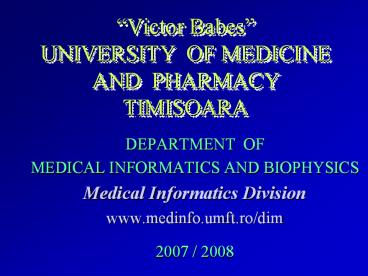- PowerPoint PPT Presentation
Title:
1
Victor Babes UNIVERSITY OF MEDICINE AND
PHARMACY TIMISOARA
- DEPARTMENT OF
- MEDICAL INFORMATICS AND BIOPHYSICS
- Medical Informatics Division
- www.medinfo.umft.ro/dim
- 2007 / 2008
2
STATISTICAL ESTIMATION STATISTICAL TESTS (I)
- COURSE 4
3
STATISTICAL ESTIMATION
4
1.1. Numerical variables - example
- A STUDY ON CHILDREN SOMATIC DEVELOPMENT
- N 25 children, age 10, Timisoara, 1997
- mean X 137 cm
- standard deviation s 5 cm
- Can we extend conclusions to the entire
population? - For several samples, various averages!
5
1.2. GRAPHICAL REPRESENTATIONSIndividual values
continuous lineSample means dotted line
6
1.3. Population characteristics
- Population mean µ
- Standard error of the mean
7
EXAMPLE
- A STUDY ON CHILDREN SOMATIC DEVELOPMENT
- N 25 children, age 10, Timisoara, 1997
- mean X 137 cm
- standard deviation s 5 cm
- standard error of the mean sx 1 cm
8
1.4. LOCALIZATION OF POPULATION MEAN
9
Relations
- Standard deviation
- Variation coefficient
- Standard error of the mean
10
- 1.5. DEFINITIONS
- a) STANDARD DEVIATION
- DISPERSION INDICATOR SHOWING INDIVIDUAL VALUES
SPREADING AROUND SAMPLE MEAN - b) STANDARD ERROR OF THE MEAN
- DISPERSION INDICATOR SHOWING SAMPLE MEAN
SPREADING AROUND POPULATION MEAN
11
EXERCISE
- For a group of N 36 cardiac patients we found
the mean blood systolic pressure of 150 mm Hg
with a standard deviation of 12mm. - a) In which interval are there located 68 of
patient systolic pressure values ? - b) In which interval can we find the mean
systolic pressure with 95 probability ? - c) What percent of pacients have values above 162
?
12
1.6. Generalization
- LOCATION OF POPULATION CAHARACTERISTICS
- TYPES
- MEANS
- PROPORTIONS
- DIFFERENCES (MEANS, PROPORTIONS)
13
- 1.6.a. MEAN ESTIMATION
- LARGE SAMPLES N gt 30
- X NORMAL DISTRIBUTION
- (REGARDLESS INDIVIDUAL DISTRIBUTION)
- 68 - 1 95.4 -
2 - 90 - 1.65 99 -
2.58 - 95 - 1.96 99.7 - 3
14
- 1.6.b. SMALL SAMPLES N lt 30
- X - t DISTRIBUTION
- DEGREES OF FREEDOM
- 1.6.c. PROPORTIONS
15
STATISTICAL TESTS
16
2. STATISTICAL TESTS
- 2.1. SIGNIFICANT AND NONSIGNIFICANT DIFFERENCES
- a) Example
- BOYS GIRLS
- n 25 n 25
- X 137 cm X 138.5 X 139.5
- s 5 cm s 5
- sx 1 cm sx 1
- (135, 139) ...95 nonsignificant significant
17
b) DEFINITIONS
- NON-SIGNIFICANT DIFFERENCES
- High probability to occur by chance
- Sampling variability
- The two samples belong to the same population
- SIGNIFICANT DIFFERENCES
- Low probability to occur by chance
- Must have another cause
18
(No Transcript)
19
(No Transcript)
20
2.2. STATISTICAL HYPOTHESES
- a) NULL HYPOTHESIS
- H0 X1 X2 ( not mathematical equal, but
statistical!) - There are no significant differences between the
two values (samples) - b) ALTERNATE HYPOTHESES
- H1 X1 ? X2 (bilateral)
- X1 gt X2 , X1 lt X2 (unilateral)
21
- 2.3. SIGNIFICANCE THRESHOLD
- a) DEFINITION
- value of probability below which we start
consider significant differences - b) VALUE
- a 0.05 5
- c) CONFIDENCE LEVEL
- 1 - a 0.95 95
- 2.4. P COEFFICIENT
- P probability that the observed differences
have occurred by chance (sampling variab.)
22
2.5. DECISION
- If p gt 0.05 gt Non-significant differences, (N)
, H0 accepted - If p lt 0.05 gt Significant differences, (S), H0
rejected - If p lt 0.01 gt Very significant differences,
(V), H0 rejected - If p lt 0.001 gt Extremely significant
differences, (E)
23
3. TESTS CHARACTERISTICS
- 3.1. ERRORS
- TYPE I H0 TRUE, BUT REJECTEED
- TYPE II H0 FALSE, BUT ACCEPTED
- 3.2. TEST CONFIDENCE 1 - a
- TEST POWER 1 - b
- inverse proportionality
24
- 3.3. Parametric and nonparam.
- Parametric - for normal distributed variables
- Nonparametric - for other distributions
- 4. CLASSES OF TESTS
- SIGNIFICANCE TESTS
- HOMOGENEITY T.
- CONCORDANCE T.
- INDEPENDANCE T.
- CORRELATION COEFICIENT TESTS
25
- e n d -

